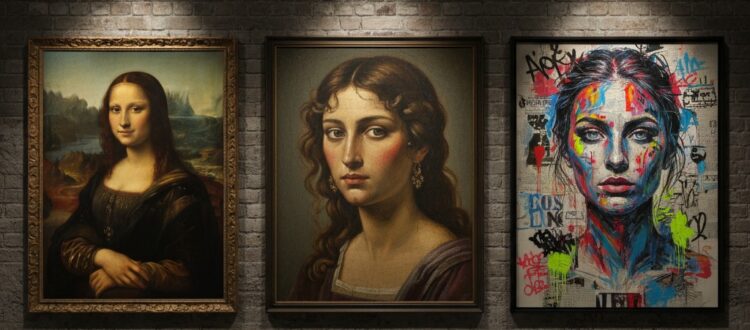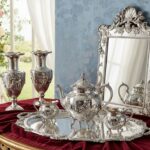Beyond the Canvas: The History of Portraiture Painting
Portrait painting is one of the oldest art forms in the world, still as popular today as it was hundreds and even thousands of years ago. Have you ever wondered how portrait art painting first began and evolved over time?
Portraits have always been more than faces on canvas — they’re stories, emotions, and eras frozen in paint.
From ancient times to today, portraiture in art has fascinated humanity. Imagine a person forever immortalised as a work of art. By looking at who was portrayed, and how, we are able to gain insights into social, cultural and political history.
The very first portrait is attributed to the artists of the Old Egyptian Empire, and it was entirely dedicated to the deceased, to kings and to divinities and to pharaohs.
In this blog, we’ll take a closer look at the fascinating history of portraiture, understand how portrait art evolved through the ages and explore the many forms this art has taken over time, from delicate portrait watercolour painting to classical oil paintings.

What Is Portraiture?
A portrait is typically defined as a representation of a specific individual, such as one the artist might meet in life. There are a myriad of portrait styles throughout history, ranging from the classic portrait to self-portraits and portrait photography.
At its heart, portraiture is the art of representing people — not just their appearance, but their essence.
History of Portrait Painting
- Early Beginnings: the Egyptians

The story of portrait painting began thousands of years ago. Ancient Egyptians painted portraits of their pharaohs and nobles on tomb walls. Initially, these portraits, called “funeral portraits”, were not meant to be seen by the living.
One well-known example is the famous Fayum mummy portraits, which were painted in Egypt between the 1st and 3rd centuries AD to immortalise the dead.
- Ancient Greece and Rome
In ancient Greece and Rome, portraiture took on a more human turn. Busts, frescoes, and encaustic paintings depicted emperors, soldiers, and philosophers with a realism that revealed not just beauty but age, wisdom, and status.
- Medieval & Middle Ages Portraiture

At the start of the Middle Ages in Europe, painting techniques were only taught to leaders of the Christian church. During this era, portrait painting diverged significantly across different regions. In Europe, portraits often highlighted a person’s social status, featuring gold backgrounds and religious symbols.
Artists painted saints, biblical figures, and monarchs — not as individuals, but as spiritual ideals. Some noteworthy portraits of this era:
“Enthroned Madonna with Child“: These are religious subjects featuring the Virgin Mary seated, with the Christ child on her lap, often on an ornate throne.
- Renaissance: The Birth of the Individual
Portraiture emerges as an independent genre of painting. This era also sees the rise of the artist’s self-portrait. The Renaissance birthed some of the greatest artists of all time, from Leonardo da Vinci, Michelangelo, and Raphael, whose great works continue to influence portraiture art today. It was during this time that portraiture began to become highly sought after not only by royalty and the elite but by everyday people. At the same time, other cultures were developing their own approaches. In India, Mughal Empire artists blended Persian and European techniques to create portraits that were both lifelike and decorative. Emperors Akbar and Jahangir championed this innovative style, fostering a fusion of cultural traditions.
An example of a noteworthy portrait and artist: Mona Lisa by Leonardo da Vinci
- Baroque to Romanticism: Drama, Light, and Emotion

By the 17th and 18th centuries, portraiture grew grand, emotional, and theatrical. The Baroque era emphasized contrast — light and shadow, opulence and mystery. Rembrandt’s portraits glowed with introspection, while Caravaggio’s chiaroscuro dramatized human form like never before.
Later, in the Rococo and Romantic eras, portraiture took a softer, more emotional turn. Artists like Thomas Gainsborough and Francisco Goya painted nobility and everyday people alike.
Noteworthy Portrait and artist: Girl with a Pearl Earring by Johannes Vermeer.
- The 19th Century: Photography and Realism
The 19th century brought a game-changer: photography. For the first time, anyone could have their likeness captured quickly and cheaply.
Artists like John Singer Sargent, Édouard Manet, and Gustave Courbet turned portraiture into a dialogue between realism and artifice. They focused less on perfect representation and more on atmosphere, expression, and mood.
Some noteworthy portraits: Olympia by Edouard Manet and Woman in a Green Dress by Claude Monet
In India, the influence of British academic art fused with local traditions, inspiring artists like Raja Ravi Varma, whose portraits blended Western realism with Indian subjects, bringing gods and royalty vividly to life.
- 20th Century: Breaking the Mold

By the 20th century, portrait painting shattered all its old rules. Movements like Cubism, Expressionism, and Surrealism reinvented the human face in radical ways. Portraiture remained a dim art until the early 1960s, when famous pop artists like Andy Warhol and Roy Lichtenstein revived portraiture as a part of modern fine art.
Noteworthy Portraits and artists: Elizabeth Taylor by Andy Warhol, Marilyn Monroe by Andy Warhol
Across the globe, modern Indian painters like Amrita Sher-Gil and M.F. Husain infused portraiture with local spirit, emotion, and abstraction — bridging East and West, tradition and modernity.
- Today’s Portraits: Diversity, Identity, and Digital Expression
Today, portrait painting is as vibrant and diverse as ever. Contemporary artists draw from the rich history of the genre while incorporating new techniques, perspectives, and subject matter. Artists today might incorporate mixed media, digital elements, or even performance art into their portrait practices.
Also Read: 10 Most Expensive Paintings Sold
Media of Portrait Art
Throughout history, portraiture has evolved across mediums — from marble and charcoal to oils, acrylics, and even digital screens.
- Oil Painting
Oil is the classic medium of portraiture, used by masters from Leonardo da Vinci to Rembrandt. It dries slowly, allowing artists to blend tones smoothly and build layers of depth.
- Watercolour
Watercolour portraits have a delicate, transparent beauty.
- Acrylic
Acrylics offer the richness of oil but dry much faster. They can be applied thick like oil paint or diluted like watercolour.
- Charcoal and Pencil
Charcoal and graphite allow artists to focus on form, light, and emotion through tone and line.
Don’t Miss This November: Giftex Modern and Contemporary Art Auction!
For collectors and art enthusiasts eager to start or add to their art collection, this upcoming Giftex Modern and Contemporary Art Auction this November is an unparalleled opportunity. This November, discover art that transcends time, speaks volumes and continues an enduring legacy.
Conclusion: Why Portraiture Still Matters
Despite technology, despite the speed of the digital age, portraiture still moves us. We see ourselves in others. A great portrait doesn’t just show a face — it tells a story, stirs a memory, or reveals something hidden.
So, if you love art, don’t miss this November’s modern and contemporary art auctions. You might just discover a masterpiece — or a new voice — that captures not only a face, but an era.






